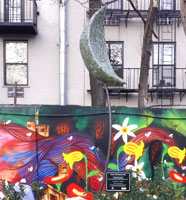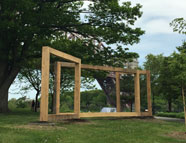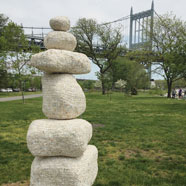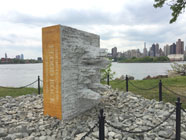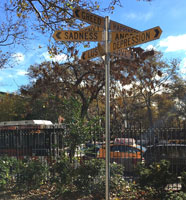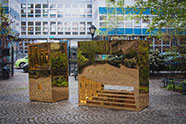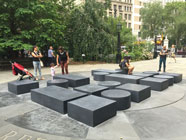Art in the Parks
Through collaborations with a diverse group of arts organizations and artists, Parks brings to the public both experimental and traditional art in many park locations. Please browse our list of current exhibits and our archives of past exhibits below. You can also see past grant opportunities or read more about the Art in the Parks Program.
Public Art Map and Guide
Find out which current exhibits are on display near you, and browse our permanent monument collection.
Search Current and Past Exhibits
2016
Manhattan
Henry Kielmanowicz, The Space Between Us
December 2015 to December 1, 2016
First Park, Manhattan
Map/Directions (in Google Maps)
Please note: This is a past exhibit that is no longer installed in the park.
Henry Kielmanowicz creates sculptures from manmade objects that enter the waste cycle, specifically glass bottles. The bottles are transformed in a labor-intensive process by breaking, crushing and separating the glass into multiple sizes creating a new raw material. Not only is Kielmanowicz reusing waste from society, he also incorporates waste produced in his own studio.
The Space Between Us, a sculpture of a moon that has been created with repurposed bottles and resin, lights the park at night.
This exhibition is presented by First Street Green.
![]()
Denise Treizman, Spartan Follies, FLOW.16
May 2016 to November 2016
Randall's Island Park, Manhattan
Map/Directions (in Google Maps)
Please note: This is a past exhibit that is no longer installed in the park.
Inspired by the concept of a fitness “boot camp” and by Randall’s Island Park’s history and role as a site for sports, Denise Treizman’s Spartan Follies lures visitors into physical and recreational interaction. Her work offers an ironically un–“Spartan” invitation through flashy forms, playful materials, and saturated colors; more than the idealized promise of a gym or a workout, her “follies” evoke a children’s playground, calling viewers to explore, play and be creative with these non–precious, interactive works of art. The works stand as objects for both contemplation and active use, shifting from object to tool, depending on public interaction, and thus invite visitors to explore the intersection between objectification and functionality. This shifting – and the playful reuse of leftover, inexpensive and readymade materials –also reflects the continued adaptation, transformation and reinvention of Randall’s Island, in its different historical roles within New York City.
FLOW.16 is presented by Randall’s Island Parks Alliance and The Bronx Museum of the Arts
![]()
Tracie Hervy, Untitled, FLOW.16
May 2016 to November 2016
Randall's Island Park, Manhattan
Map/Directions (in Google Maps)
Please note: This is a past exhibit that is no longer installed in the park.
Tracie Hervy’s Untitled is installed on a hill along the southeast waterfront of Randall’s Island Park. In the piece, three wooden frames echo Randall’s Island’s major geographical axes – thruways connecting the Bronx, Manhattan, and Queens. The frames reflect not only the physical reality of the geometries of Randall’s Island, but also the role it plays in knitting together the fabric of the city. The frames help define how visitors see the world across the river. When viewers look through the frames at skyline on the other side, they are looking through Randall’s Island.
FLOW.16 is presented by Randall’s Island Parks Alliance and The Bronx Museum of the Arts
![]()
Samantha Holmes, Hell Gate Cairns, FLOW.16
May 2016 to November 2016
Randall's Island Park, Manhattan
Map/Directions (in Google Maps)
Please note: This is a past exhibit that is no longer installed in the park.
Samantha Holmes’ Hell Gate Cairns are a series of stacked stone pillars, or cairns, that stand watch over the southern coastline of Randall’s Island Park. They are a monument to the human creativity and industry with which we have shaped the world around us, from land reclamation projects to the construction of buildings and cities. Through their simplicity of structure, Holmes embodies our impulse to imaginatively construct – stacking stones first in play, then as architecture. Their verticality mirror that of the city beyond. The surface of the cairns are covered in stone mosaic with flickers of glass and gold, reflecting the light of sun and water, and turning the medium of mosaic upon itself: stone celebrating stone, a symbol of the creative relationship between man and nature.
By focusing on the forms of natural stone, the piece draws attention to the boulders that line the Park’s paths and fields, remnants of the great earthmoving projects of the 20th century that cleared the city’s waterways – most notably the perilous “Hell Gate”, the narrow stretch of water between Randall’s Island and Queens responsible for hundreds of early shipwrecks. The monument’s placement at the water’s edge recalls these feats of human engineering, while further calling upon the cairns’ symbolism as both a memorial to the deceased, and an ancient sign of treacherous waters.
FLOW.16 is presented by Randall’s Island Parks Alliance and The Bronx Museum of the Arts
![]()
Tim Clifford, Monument to a Missing Island, FLOW.16
May 2016 to November 2016
Randall's Island Park, Manhattan
Map/Directions (in Google Maps)
Please note: This is a past exhibit that is no longer installed in the park.
Tim Clifford’s Monument to a Missing Island commemorates the destruction of the East River island known as Flood Rock, which took place on October 10, 1885. Flood Rock was the largest impediment to shipping in the East River, slowing commercial traffic to and from Long Island Sound. The explosion that eliminated Flood Rock, overseen by the Army Corps of Engineers, was the largest man-made explosion in human history prior to the atom bomb.
The piece is sited along the southern pathway of Randall’s Island, in view of Flood Rock’s former location. The monument renders an image of the Flood Rock explosion through the displacement of nearly 9000 lengths of wood (reminiscent of the classic toy known as a “pinscreen”). Tipped on its side–so that both the bottom and top of the monument are visible–Clifford’s work literally upends the traditional monument and illustrates the force and displacement at work in man’s carving of the East River channel.
FLOW.16 is presented by Randall’s Island Parks Alliance and The Bronx Museum of the Arts
![]()
Stuart Ringholt, Signpost (2007-2015)
November 10, 2015 to November 4, 2016
First Park, Manhattan
Map/Directions (in Google Maps)
Please note: This is a past exhibit that is no longer installed in the park.
In conjunction with his exhibition nudes, signs, and a contract at OSMOS Address, Stuart Ringholt, Ringholt installed an accompanying large-scale sculpture entitled Signpost (2007-2015) in nearby in First Park. Using the standard materials for a street sign, the artist facilitates an unexpected encounter with the range of emotions named on arrows pointing in different directions.
This exhibition is presented by Milani Gallery, Brisbane, OSMOS Address and First Street Green.
![]()
Jose Soto, Focus
May 6, 2016 to November 1, 2016
Harlem Art Park, Manhattan
Map/Directions (in Google Maps)
Please note: This is a past exhibit that is no longer installed in the park.
With its shiny, reflective panels and rectangular apertures, Focus combines the illusionism of photography with physical presence to fully engage the spectator. It is concerned with how photography shapes the way we see the world and the viewer’s visual perception and bodily experience. By limiting the scope of view, viewers can take more control over their focus of attention and see things in a mindful way.
This work is an extension of May 2016’s FLUX Public Art Projects, a FLUX Art Fair initiative. FLUX embodies Harlem’s creative spirit and cultural significance by bringing together original works, from large sculptural works and sound pieces to performance art and thought-provoking installations.
This exhibition is presented by Art in FLUX, FLUX Art Fair, and Marcus Garvey Park Alliance.
![]()
Isca Greenfield-Sanders, Playground Parachutes
October 1, 2016 to November 1, 2016
Vesuvio Playground, Manhattan
Map/Directions (in Google Maps)
Please note: This is a past exhibit that is no longer installed in the park.
Playground Parachutes is an installation of four large-scale murals by New York-based artist Isca Greenfield-Sanders, made in collaboration with over 200 children at the Children’s Museum of the Arts. For this community-based, public art project the artist chose an image from her 2008 parachute series, which she gridded into 72 square tiles and printed in the four basic CMYK colors. The tiles were then enhanced with colored pencils by young artists who explored mark making techniques with CMA Teaching Artists. The colored pieces were returned to the artist, who reassembled the composition. Each piece can be singled out in the larger composition, but when taken within the whole piece, each specific style blends into the overall picture. The artist’s original image is now enhanced with the visions of the many students who added to the tiles.
This exhibition is presented by Green Below 14 and SmartSpaces, in partnership with the Children’s Museum of the Arts.
![]()
Suprina Kenney, DNA Totem
March 28, 2016 to September 30, 2016
Marcus Garvey Park, Manhattan
Map/Directions (in Google Maps)
Please note: This is a past exhibit that is no longer installed in the park.
The DNA Totem is a 10’ tall spiral in the shape of a DNA helix that is embedded with detritus and discarded items donated by community residents as well as found objects from the artist. The looming structure serves as an historical reference to human evolution and the footprint humans leave behind. The DNA Totem will be on view on the southern overlook terrace near the Fifth Avenue and 120th Street entrance to Marcus Garvey Park, a historic Harlem park located at the intersection of East and Central Harlem just 10 blocks north of Museum Mile.
According to the artist, “The DNA Totem is meant to bring up for discussion the seemingly unconscious disregard for how we affect our planet. I do this by showing a very small sampling of unwanted objects on the iconic, universal structure that is life itself; the DNA strand. Even though this symbol represents all living things, we have forced our compulsion for ‘the next best thing’ onto all others we share this planet with, usually with bad result. Using visual mapping I celebrate us, and our absurdity. We are beautiful, horrid, tragic, and profoundly funny.”
This exhibition is presented by the Marcus Garvey Park Alliance and Art in FLUX.
![]()
Various Artists, Language of Things
June 28, 2016 to September 29, 2016
City Hall Park, Manhattan
Map/Directions (in Google Maps)
Please note: This is a past exhibit that is no longer installed in the park.
Language of Things, a thematic group exhibition explores the nature of language and communications extending beyond spoken and written word. Drawing its title from Walter Benjamin’s essay On Language as Such and on the Language of Man (1916), the show features a diverse international group of seven artists: Carol Bove, Claudia Comte, Michael Dean, Adam Pendleton, Tino Sehgal, Chris Watson, and Hannah Weiner. The show features new and existing objects, a live artwork, sound installation, and poetry suggestive of different forms of coded communication–both manmade and natural–between a person and an object, among people and nature, or connecting people with one another. It speaks to our innate desire to read and understand the patterns and codes inherent in the world around us.
This exhibition is presented by Public Art Fund.
![]()
